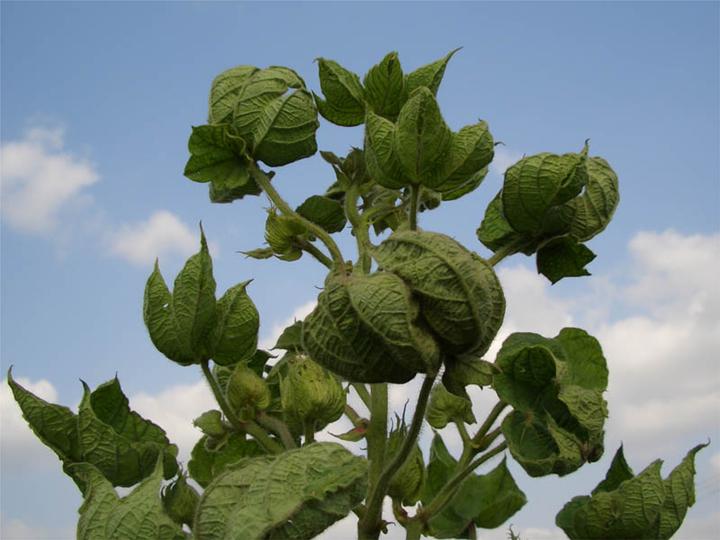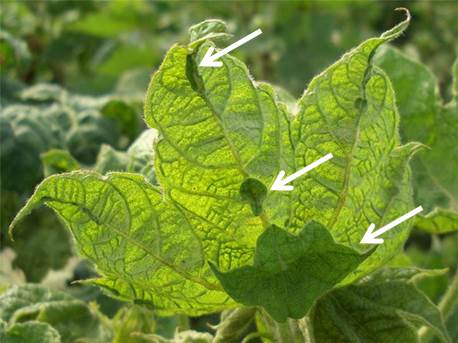
Cotton leaf curl disease
| Primefact number | Edition | Published | Author |
|---|---|---|---|
| 1407 | First | May 2015 | Plant Biosecurity and Product Integrity |


Cotton leaf curl disease is an exotic plant pest not present in Australia. This virus is a serious threat to Australia’s cotton industry.
Cotton leaf curl disease (CLCuD) is a viral infection of cotton and other susceptible host plants that is transmitted by silverleaf whitefly (Bemisia tabaci).
There are a number of different cotton leaf curl viruses (Begomovirus species) associated with CLCuD.
The disease generally requires host plants to be infected with both a cotton leaf curl virus and an associated betasatellite component in order to produce symptoms.
Plants that are infected with a cotton leaf curl virus, but not the betasatellite, may appear symptomless.
Notifiable status
Cotton leaf curl disease is a notifiable plant disease in NSW.
All notifiable plant pests and diseases must be reported within 1 working day. You can report notifiable plant pests and diseases by one of the following methods:
- Call the Exotic Plant Pest Hotline 1800 084 881
- Email biosecurity@dpi.nsw.gov.au with a clear photo and your contact details
- Complete an online form
A full list of notifiable plant pests and diseases can be found in Schedule 2 of the NSW Biosecurity Act 2015.
Description
Symptoms of CLCuD on infected cotton plants usually appear within 2−3 weeks. Early symptoms include deep downward cupping of the youngest leaves accompanied by swelling and darkening of leaf veins.
Later stages of infection involve the upward or downward curling of leaf margins (Figure 1) accompanied by leaf yellowing or mosaic.
Cup shaped, leaf like structures (enations) may form along leaf veins, typically on the underside of leaves (Figure 2).
Damage
Early or severe infection of CLCuD may lead to stunted plant growth. Infection while the plant is still young can significantly impact flowering, boll formation, maturation, yield and lint quality.
When infection occurs early in the growing season, or in highly susceptible cultivars, it is estimated up to 20% of production may be lost.
Host range
Preferred hosts of CLCuD are cotton and closely related species.
Cotton leaf curl viruses can also infect soyabean, okra, eggplant, tomato, chilli, cowpea, radish, tobacco, cucumber, melons and hibiscus.
Spread
Both the cotton leaf curl virus and the associated betasatellite required to produce CLCuD symptoms are transmitted by silverleaf whitefly.
Silverleaf whitefly is present in Australia and is a known vector of other established plant viruses (such as tomato yellow leaf curl virus). Silverleaf whitefly transfers viruses through sap as it feeds.
Cotton leaf curl disease could spread to Australia with the introduction of silverleaf whiteflies carrying the disease, or in infected planting material. The spread of CLCuD overseas has generally occurred with the movement of infected ornamental plants, specifically hibiscus.
Once introduced to Australia, established populations of silverleaf whitefly could help to quickly spread the virus.
Distribution
Cotton leaf curl disease is known to occur in Pakistan, India, Egypt, Nigeria, Tanzania, Sudan, and more recently China and the Philippines.
There are a number of different cotton leaf curl viruses known to cause CLCuD and their occurrence varies in areas of known distribution.
Neither viruses causing CLCuD nor betasatellites are known to occur in Australia.
Actions to minimise risk
Put in place biosecurity best practice actions to prevent entry, establishment and spread of pests and diseases:
- practice “Come clean, Go clean”
- ensure all staff and visitors are instructed in and adhere to your business management hygiene requirements
- monitor your crop regularly
- monitor and control silverleaf whiteflies
- keep records

